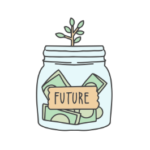
Am I Impacted by the SECURE Act?
February 24, 2025
Weathering Market Turbulence: A Q2 Update
April 15, 2025
Dr. Joe Coughlin, Director of the MIT AgeLab, said “Now that we have achieved what humankind has tried to achieve since it has walked—living longer—we really don’t have a good idea of what to do with all that additional time.” MIT Agelab partnered with Hartford Funds on a whitepaper about this topic and did the math, dividing a lifetime into four 8,000 day periods (birth to 22, to midlife at 44, to retirement at 66, to death in 80s).
I often place an image depicting the four phases of transition on the table between a client and myself. It lays out a visual image of anticipation, when something big is changing, to ending, which overlaps into the largest bubble: passage. Then the final phase, new normal. What I love about the graphic is the proportions: anyone who has grieved a loss resonates with the size and scope of passage and how much longer it takes to arrive at new normal than one imagines.
What I like less about it is that it appears linear, and travelers on this journey know it’s not. A new morning, a song on the radio, a scent in the air, can put one back into another phase for a moment or a month.
In my work as a Financial Transitionist who specializes in age-related transitions, I have come to see that the 8,000 days after full-time work follows a similar pattern. The challenges and opportunities have different flavors, and optimizing the good and minimizing the hard requires serious contemplation. What experiences do you want to have?
Good planning doesn’t mean you’ll get what you want, but as my favorite finance professor was fond of saying, if you don’t know where you’re going, any road will get you there.
Honeymoon
- Will you maintain social contacts from work? How will you make new friends?
- If your sense of who you are comes from your work identity, how will you replace that? Do you want a part-time job? gig work? volunteer?
- Imagine a Venn diagram, with “he” and “she” in the circles, and “we” in the overlapping segment. What will each of you do, have and be in your sphere? And crucially, what activities and commitments will nurture your connection?
- Financial security is a feeling, not a number. However, there is a number you need to know at the pivot from “accumulation” to “decumulation”: know what you can spend.
- Health is wealth. Imagine a chart mapping time and quantity. The “wealth” line goes up and to the right as typically net worth (quantity) rises as we get older (time). Unless we are diligent about changing the trajectory of the second line, health (quantity) starts in the top left and goes down to the right as time marches on. What are you going to do to take care of your body and mind with the same attention you gave to financial security?
Big Decision
Maybe you’ve been facing Sunday night with dread for a couple years. You imagine retirement and think, “I won’t have to wake up and do it all again tomorrow.” But life after full-time work isn’t one long vacation. At some point, a few weeks in or several years later, the focus shifts: I’m in my “Go-Go” years—how do I want to spend them?
- How do I want to spend my time?
- How do I want to spend my money?
- Where do I want to live?
- If I got a “hard stop” (change in health/circumstances for me or loved ones) what would I keep doing? Stop doing?
- Renew He/She/We
- Am I sleeping and moving? (strength, aerobics and flexibility)
Navigating Longevity
These are sometimes called the “Slow-Go” years. Whatever we’ve been told, aging is not a path of demise. It can be about self-determination, freedom and discovery, but you need to put in the work. Imagine the possibilities and create scenarios for how to respond.
- What would happen for me to downsize, relocate or modify my home?
- What would happen for me to get help with money?
- What would happen for me to quit driving?
- What would happen for me to get help with medical decisions and care?
- Exit continuity plan: are my affairs in order for my loved ones to continue on after my exit?
- Am I sleeping and moving?
Solo Journey
Solo agers have unique planning considerations. For some these questions will have relevance much earlier in the journey and some people will start the last 8,000 days alone.
- Books, podcasts, making art, small groups: where will you find grief support?
- How will you maintain friendships, make new ones? Do you need new activities?
- If you’re not living close to family, how will you stay connected?
- Is it time to downsize, change locations or move into a community?
- What is your continuity plan for pets if something happens to you?
- If you fell or got sick, how would your loved ones be alerted? Make a crisis response plan.
- Can you provide healthy nutrition for yourself? Are you staying physically active?
- If repartnering is in your future, the He/She/We Venn diagram exercise is essential. It’s common to find that much of what you bring with you—adult children, time commitments, financial obligations—doesn’t fit smoothly in the overlapping segment. Discuss how time, money and energy will be placed in separate spheres and identify what will sustain your togetherness.
*inspired by MITAgeLab/Hartford Funds 8000 Days Client whitepaper and workbook
